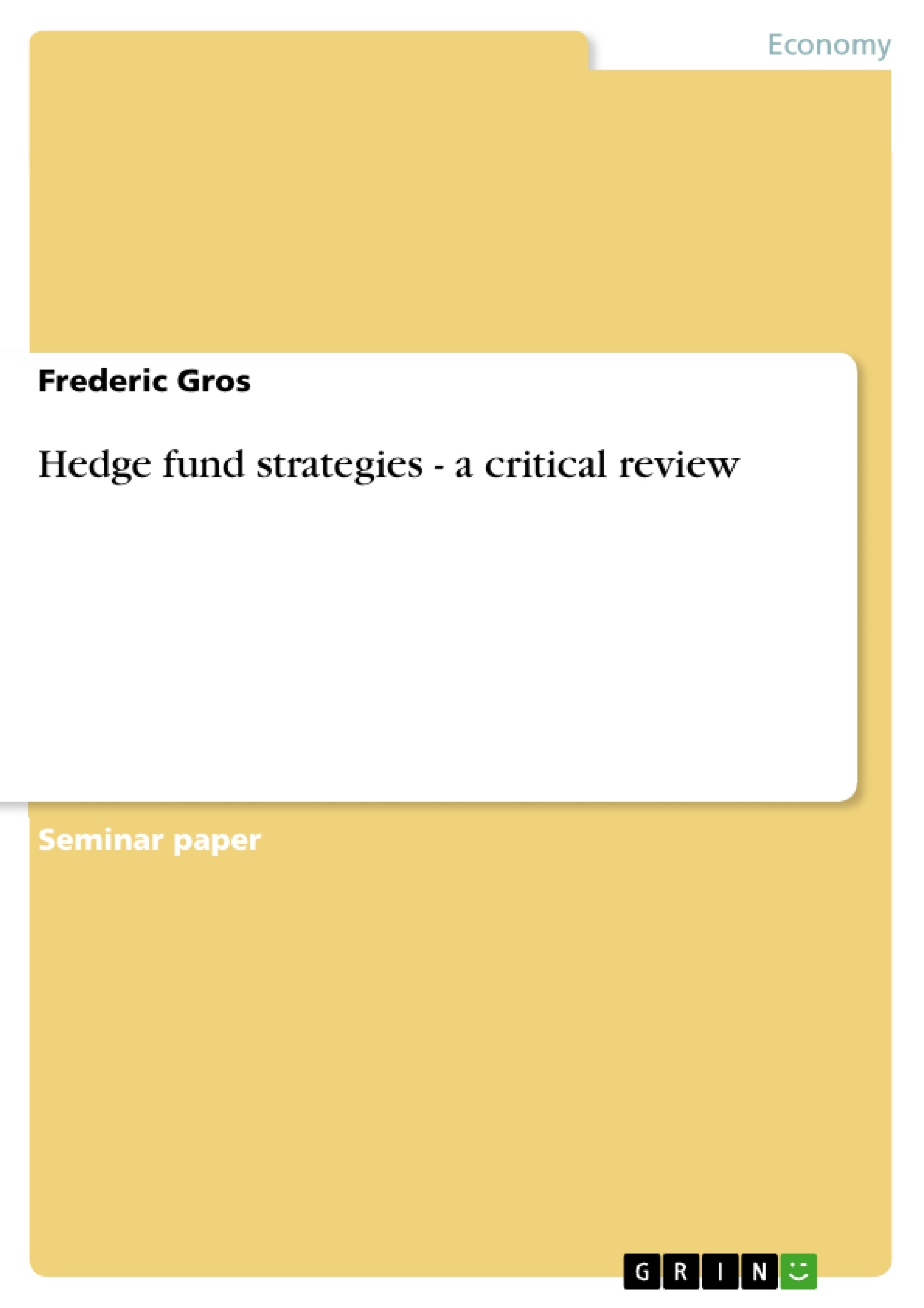Introduction
Problem and objectives
Historically, there have been two competing investment theories. On the one hand there is the traditional efficient markets theory, which states that share prices fully reflect market information and therefore only temporary mispricing occurs. The traditional investments to buy and hold equity and bonds, which benefit principally from market direction is based on this theory. On the other hand the second theory argues that greater inefficiencies occur, and therefore opportunities can arise that enable investors to exploit mispriced securities without facing excessive levels of risk. This is the principal argument behind hedge fund investing.
In the Oxford dictionary, the term “hedge” is described as a way of protecting yourself against a loss, especially money. To achieve this goal, hedge funds use a wide range of different investment strategies. These strategies are partly very complex and therefore sometimes very difficult to comprehend for the investor. This fact contributes mainly to the negative image of hedge funds in the general public. But the truth is that as hedge funds exploit chances of winning which result from market imperfections, they actually support and improve the stability of the financial systems.
The hedge fund industry experienced a very strong growth in the last two decades and represents a good alternative investment opportunity to traditional asset classes. Therefore this paper aims to provide an overview of the numerous hedge fund strategies which are applied by the increasing number of hedge funds. This knowledge is needed as some specialists already expect that traditional mutual funds may not be able to avoid adopting respectively integrating some sort of hedge fund strategies to remain competitive with hedge funds.
Structure of the paper
This paper starts with a brief outline of the development in the history of hedge funds. Then the main characteristics of hedge funds and the differences to mutual funds will be explained. Concluding the basics’ part a description of the continuously growing hedge fund universe will be provided.
Inhaltsverzeichnis (Table of Contents)
- Introduction
- Problem and objectives
- Structure of the paper
- Basics
- History
- General Characteristics
- The hedge fund Universe
- Style Analysis of different Hedge funds
- Directional hedge fund styles
- Equity long / short
- Tactical Trading
- Non-directional hedge fund styles
- Hybrid hedge fund styles
- Other hedge fund styles
- Directional hedge fund styles
- Performance and Risk Measurement
- Critical View on hedge funds
- Hedge fund data
- Hedge fund indices
- Conclusion
Zielsetzung und Themenschwerpunkte (Objectives and Key Themes)
This paper aims to provide a comprehensive overview of the numerous hedge fund strategies employed by the increasing number of hedge funds. It also aims to explain the main characteristics of hedge funds and their differences to traditional mutual funds. The paper further examines the performance and risk measurement of hedge funds and critically reviews hedge fund data and indices.
- The history and development of hedge funds
- The characteristics and strategies of different hedge fund styles
- Performance and risk measurement of hedge funds
- The critical view on hedge fund data and indices
- The future development of the hedge fund industry
Zusammenfassung der Kapitel (Chapter Summaries)
The introduction presents the problem and objectives of the paper. It explores the competing investment theories of efficient markets and market inefficiencies, highlighting the role of hedge funds in exploiting these inefficiencies. The chapter also provides an overview of the structure of the paper.
The "Basics" chapter delves into the history of hedge funds, starting with Alfred Winslow Jones's pioneering fund in 1949. It examines the evolution of hedge fund strategies and the factors that have contributed to their growth and occasional setbacks, including the collapse of Long Term Capital Management. The chapter concludes with a description of the ever-expanding hedge fund universe.
The chapter "Style Analysis of different Hedge funds" explores the diverse strategies employed by hedge funds. It categorizes hedge fund styles into directional (e.g., equity long/short, tactical trading), non-directional, hybrid, and other styles. Each style is briefly described, highlighting its core principles and investment approaches.
The chapter on "Performance and Risk Measurement" examines the methods used to assess the performance and risk of hedge funds. It delves into the challenges of accurately measuring and comparing hedge fund returns and analyzes the factors that contribute to hedge fund risk.
The chapter "Critical View on hedge funds" offers a critical perspective on hedge fund data and indices. It explores the limitations and potential biases inherent in these data sources, highlighting the importance of using caution when interpreting hedge fund performance statistics.
Schlüsselwörter (Keywords)
The key terms and concepts discussed in this paper include hedge fund strategies, performance and risk measurement, hedge fund data, hedge fund indices, market inefficiencies, absolute returns, efficient markets theory, directional and non-directional hedge fund styles, equity long/short, tactical trading, hybrid hedge fund styles, and the history and development of the hedge fund industry.
- Arbeit zitieren
- Dipl. Kfm Frederic Gros (Autor:in), 2005, Hedge fund strategies - a critical review, München, GRIN Verlag, https://www.grin.com/document/52530



